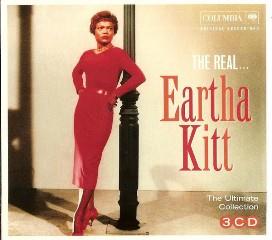Eartha Kitt - The Real... Eartha Kitt CD3 (2015)
Eartha Kitt - The Real... Eartha Kitt CD3 (2015)

3-1 Mademoiselle Kitt (Mesi Julian) 3-2 If I Love Ya, Then I Need Ya; If I Need Ya, Then I Want Ya Around 3-3 Just An Old Fashioned Girl 3-4 Two Lovers 3-5 Fascinating Man 3-6 Hey Jacque 3-7 Somebody Bad Stole The Wedding Bell (Who's Got The Ding-Dong) 3-8 Uska Dara - A Turkish Tale 3-9 The Day That The Circus Left Town 3-10 If I Can't Take It With Me (When I Go) 3-11 Looking For A Boy 3-12 Thursday's Child 3-13 Monotonous 3-14 The Heel 3-15 Apres Moi
A life is very difficult to capture, whatever medium or genre one works in: life, after all, is experienced from the inside, being predominantly made up of what Virginia Woolf termed ‘moments of being’. And yet we console ourselves with the idea that actions speak louder than words; that by examining one another’s behaviour we get a sense of someone’s essential self. This, of course, presupposes the stuff of inner experience finds full and meaningful expression in concrete, observable actions.
Nowhere have I sensed so thoroughly the futility of this presupposition than in John L Williams’ America’s Mistress. Here, the gap between Williams’ description of the life lived and his subject’s experience of living seems to be so great that upon closing the book my feeling was one of total bewilderment. Williams himself acknowledges the slipperiness of Eartha Kitt, drawing attention throughout the book to the many, often 'contradictory' roles she adopted throughout her life. But he fails to transform what he describes as a 'morass of detail' into a portrait of a living, breathing person.
It is difficult to tell whether this is due to Kitt’s essential mystery – perhaps the result of such self-mythologising that fiction and reality appeared to co-exist in her mind (the result, Williams says, of her wanting to 'build her own reality') – or simply to the nature of her career, which relied upon her cultivating a number of conflicting personas. What is clear is that the confusion of the book reflects the confusion of its subject. At one point, Williams describes Kitt’s own autobiography as 'a frustrating book, an impressionistic affair that leaves much unanswered'; yet this serves as a more than adequate description of his own biography.
Eartha Kitt was born Eartha Mae Kitt in the South Carolina lowlands in 1927. She never met her father (a white doctor named Starkie), and her black mother – who worked for Starkie as a domestic servant – abandoned her when Eartha was around three or four years old. Eartha’s existence, according to Williams, was 'a shame and a scandal', and Kitt was haunted for the rest of her life by her mother’s act of abandonment. Williams plots these early years of her life – including her move to 1930s Harlem and subsequent training at the Dunham Company studio – with some degree of energy. He includes vivid descriptions – frequently based on his own interviews and research – of the New York music scene and its dynamic array of characters. (In fact, it is when he strays off-topic and writes about the peripheral players in Eartha’s life that the prose becomes playful and absorbing.) In light of this – since Williams allows himself a number of little detours – the first half of the book is far richer and more rewarding than the second.
Unfortunately, once Eartha’s career begins to enjoy some success, the descriptions become repetitive and monotonous. After working in Europe as a cabaret artist and actress, she returns to America, and Williams documents endless shows, outfits, venues. He also – somewhat annoyingly – plays a ridiculous game of ‘did she-didn’t she’ with just about every man Kitt meets. His obsession with detailing the effect she had on men, as well as the abundant quotes from (male) admirers or reviewers describing her 'strange intensity' and 'intensely dramatic eyes' starts to grate. By the time the action gets interesting again – Kitt’s involvement in the Civil Rights movement and her very public strop at the White House – I felt almost totally disengaged from the story.
The most frustrating thing about America’s Mistress, however, is the fact that Williams identifies exactly why Kitt is such an interesting character: she is always on the cusp – black/white; sexy/childlike; vulnerable/strong. She is always 'the odd one out' – and always, it seems, at odds with herself. Yet he can’t seem to get to grips with Kitt’s 'tumultuous life'. It’s as if the material overwhelms him. The other problem is that her career – like her personality – is so utterly unpredictable and unconventional. She is both cabaret artiste and serious actress; sultry 'sex kitten' chanteuse and wannabe intellectual. There are moments of insight where we glimpse the strange combination of fragility and ambition which seem to drive her. (Most obviously these moments come when Williams allows Eartha herself to speak; as an interviewee she is most revealing.) But for the most part, he makes no attempt to truly draw out and analyse her character.
Hidden beneath salacious speculation (which frankly becomes banal) and the obsessive drawing out of details relating to Eartha’s sexual life there is a complex, gripping story. Her behaviour is often unpredictable; occasionally downright bizarre, hinting at the need for a much deeper analysis of this complicated and conflicted woman. Williams, in my view, just isn’t the man for the job. ---John L Williams, newwelshreview.com
download (mp3 @320 kbs):
Zmieniony (Wtorek, 29 Maj 2018 14:09)








